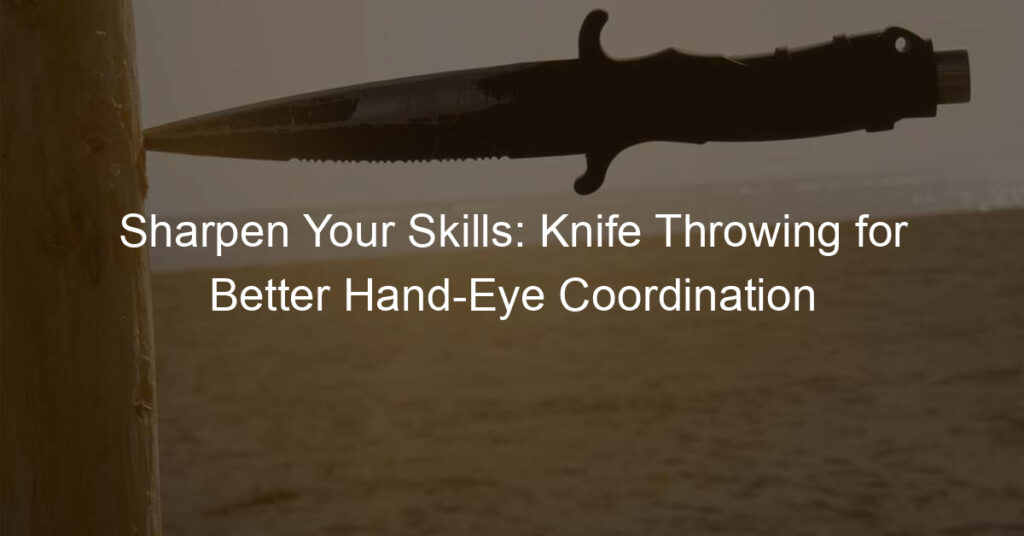Introduction to Knife Throwing Competitions
Knife throwing competitions are a thrilling spectacle that combines precision, skill, and nerve. These tournaments are not just about throwing a knife at a target, but also about understanding the art and science behind the throw. Let’s delve into the fascinating world of knife throwing competitions.
-
- Overview of Knife Throwing Tournaments
Knife throwing tournaments are organized events where competitors throw knives at a target from a specified distance. The goal is to hit the target as accurately as possible. These tournaments can be local, regional, national, or even international, and they attract a wide range of participants, from beginners to seasoned professionals. The rules and scoring systems can vary, but the common factor is the emphasis on precision and control.
Back to ancient times, when it was used for hunting and warfare. However, it wasn’t until the 19th century that knife throwing began to emerge as a competitive sport. The first recorded knife throwing competition took place in France in 1870. Since then, the sport has grown in popularity, with numerous competitions being held worldwide. Wikipedia provides a comprehensive history of knife throwing.
-
- Popularity and Growth of Knife Throwing Competitions
According to the International Knife Throwers Hall of Fame, the number of knife throwing clubs has doubled in the last decade. This growth is attributed to the sport’s unique blend of skill, concentration, and thrill. The rise of televised tournaments and online streaming has also played a significant role in popularizing knife throwing competitions.
Professional Knife Throwing
Getting Started in Professional Knife Throwing
-
- Understanding the Basics
This includes learning about the different types of throwing knives, how to grip and throw the knife, and the safety measures you need to take. You can learn these basics from books, online resources, or by attending a beginner’s class. Wikipedia also has a comprehensive article on knife throwing that you can read to get started.
-
- Joining a Local Knife Throwing Club
Joining a local knife throwing club can provide you with the opportunity to learn from experienced throwers, practice regularly, and get feedback on your technique. You can find local clubs through online directories or by asking around in your community.
-
- Entering Amateur Competitions
Can give you a taste of what professional knife throwing is like and help you gain experience in a competitive setting. You can find information about upcoming competitions on the websites of knife throwing clubs or organizations.
Advancing in Professional Knife Throwing
-
Training and Practice Techniques
Improving your knife throwing skills requires consistent and focused practice. Start by setting a regular practice schedule. This could be daily or several times a week, depending on your availability. It’s also important to vary your training routine to avoid plateauing. For example, you could alternate between distance throwing and accuracy drills.
Another effective training technique is to record your practice sessions. This allows you to review your form and identify areas for improvement. Quality is more important than quantity.
-
Competing in National and International Tournaments
A great way to test your skills and gain experience. Start with local or national competitions before moving on to international ones. This gradual progression will help you build confidence and improve your performance under pressure.
When preparing for a tournament, it’s crucial to familiarize yourself with the rules and scoring system. This will help you develop a strategic approach to your throws. Additionally, participating in tournaments exposes you to different throwing styles and techniques, providing valuable learning opportunities.
-
Building a Reputation and Gaining Sponsorship
Requires time, effort, and consistent performance. Start by participating regularly in competitions and networking with other throwers. Sharing your experiences and knowledge on social media or a personal blog can also help you gain recognition.
Knife Throwing Techniques
Basic Knife Throwing Techniques
-
- Grip Techniques
The way you hold your knife plays a crucial role in the success of your throw. There are several grip techniques, but the most common one is the hammer grip. In this technique, you hold the knife handle as if you were holding a hammer, with your fingers wrapped around the handle and your thumb resting on top. This grip provides a firm hold and allows for a controlled throw.
-
- Throwing Stances
The most common stance is the upright stance, where you stand straight with your feet shoulder-width apart. Your dominant foot should be slightly behind, and your body should be facing the target. This stance provides stability and allows for a full range of motion when throwing.
-
- Targeting Techniques
Advanced Knife Throwing Techniques
-
- Multiple Knife Throws
Throwing multiple knives at once is a technique that requires precision, timing, and control. It involves throwing two or more knives in quick succession, aiming at different parts of the target. This technique can be quite impressive when executed correctly. However, it requires a lot of practice to master the timing and coordination needed.
-
- Trick Throws
These throws often involve complex movements or stunts, such as throwing a knife while spinning or jumping. Trick throws can be a great way to impress the audience and the judges in a competition. Only attempt these throws if you are confident in your skills and are using the proper safety equipment.
-
- Distance Throws
The goal is to throw the knife as far as possible while still hitting the target. This technique requires a strong arm and a good understanding of the knife’s trajectory. It’s a challenging technique, but it can earn you a lot of points in a competition if you can pull it off.
Knife Throwing Rules and Scoring
-
Standard Rules of Competitive Knife Throwing
Participants are required to throw their knives from a specified distance, usually between 10 and 16 feet from the target. The knife must make at least one complete rotation before hitting the target. The handle of the knife should not touch the target before the blade. Throwing knives should not have any sharp edges or points other than the intended point. More details can be found on Wikipedia.
-
Scoring System in Knife Throwing Competitions
The target is divided into several concentric circles, with the center circle (bullseye) usually worth the most points. The points decrease as you move outward from the center. Only throws where the knife sticks to the target are scored. The total score of a participant is the sum of points from all successful throws.
-
Common Rule Variations in International Competitions
While the basic rules of knife throwing are generally the same worldwide, there are some variations in international competitions. For instance, the required distance from the target may vary, and some competitions may allow the knife to make more than one rotation before hitting the target. Some competitions may also have different scoring systems or target designs. It’s always important for competitors to familiarize themselves with the specific rules of the competition they are entering. More information can be found on Wikipedia.
Knife Throwing Training
Physical Training for Knife Throwing
-
- Strength Training
It helps to improve your grip, arm, and shoulder strength, which are crucial for accurate and powerful throws. Exercises like push-ups, pull-ups, and weightlifting can be beneficial. The goal is not to bulk up, but to build lean muscle that can aid in your throwing technique.
-
- Flexibility and Coordination
They enhance your ability to maintain balance, aim accurately, and execute throws smoothly. Incorporate exercises like yoga and pilates into your training routine. These exercises not only improve flexibility but also enhance body awareness and coordination.
-
- Endurance Training
For maintaining energy and focus during long throwing sessions or competitions. Cardiovascular exercises like running, cycling, or swimming can help build your endurance. To be able to maintain your performance level over a prolonged period without fatigue.
Physical training for knife throwing is a continuous process. It is important to maintain a consistent training routine and gradually increase the intensity of your workouts. With time, dedication, and proper training, you can enhance your physical capabilities and improve your knife throwing skills.
Mental Training for Knife Throwing
-
- Focusing Techniques
It is essential to maintain a clear mind and concentrate on your target. One effective focusing technique is the “one-pointed mind” method, where you focus your attention solely on your target, eliminating all other distractions. This technique can be practiced through meditation exercises, helping you to improve your concentration and accuracy.
-
- Handling Pressure and Competition Nerves
One way to do this is by practicing under similar conditions. By simulating the competition environment during your training sessions, you can become more comfortable and less nervous when the real competition comes. Additionally, deep breathing exercises can help calm your nerves and keep your mind clear.
-
- Mental Visualization and Preparation
A powerful tool in any sport, and knife throwing is no exception. By visualizing your throw before it happens, you can mentally prepare yourself for success. Imagine the trajectory of the knife, the feel of the release, and the knife hitting the target. This mental preparation can significantly improve your performance and increase your confidence.
Knife Throwing Safety
-
- Safety Equipment for Knife Throwing
First and foremost, it’s important to wear the right safety gear. This includes sturdy gloves to protect your hands, eye protection to shield your eyes from any flying debris, and closed-toe shoes to protect your feet. It’s also a good idea to have a first aid kit on hand in case of any minor injuries. Safety should always be your top priority when participating in knife throwing.
-
- Safe Knife Handling and Throwing Practices
Handling and throwing knives safely is crucial to prevent accidents. Always hold the knife by the handle, not the blade. When throwing, make sure you have a clear and unobstructed path to the target. Never throw a knife at a person or animal, and always make sure the area behind your target is clear. Practice your throwing technique in a controlled environment before attempting it in a competition or public setting.
-
- Emergency Procedures and First Aid
In the event of an accident, it’s important to know how to respond. If someone is injured by a thrown knife, call for medical help immediately. While waiting for help to arrive, apply pressure to any bleeding wounds and try to keep the injured person calm. It’s a good idea to take a basic first aid course so you’re prepared for any emergencies that may arise during knife throwing.
Knife Throwing Equipment
Choosing the Right Knife for Throwing
-
- Types of Throwing Knives
Blade-heavy, handle-heavy, and balanced knives. Blade-heavy knives are easier to throw from the handle, while handle-heavy knives are easier to throw from the blade. Balanced knives, on the other hand, can be thrown from either the blade or the handle. For beginners, a balanced knife is often recommended as it provides more flexibility and ease of learning. You can read more about the types of throwing knives on Wikipedia.
-
- Weight and Balance Considerations
A knife that is too light may not travel straight or far enough, while a knife that is too heavy may be difficult to throw accurately. A good rule of thumb is to choose a knife that weighs about 200 grams for every meter of throwing distance. As for balance, a well-balanced knife will rotate more predictably, making it easier to hit your target.
-
- Knife Maintenance and Care
Always clean your knife after use to prevent rust and dullness. Regularly check for any damages or deformities, especially after a hard throw. If you notice any chips or cracks, it’s best to replace the knife to avoid any potential safety hazards. Lastly, store your knife in a dry, cool place to prevent any damage from humidity or heat.
Other Essential Equipment for Knife Throwing
-
- Targets and Backstops
They are usually made of soft wood, such as pine or cedar, which allows the knife to stick easily. The size and design of the target can vary, but a common choice is a circular target with concentric circles, similar to a dartboard. Backstops, on the other hand, are used to catch any missed throws and protect the surrounding area. They are typically made of a sturdy material like plywood.
-
- Safety Gear
Safety should always be the top priority when participating in knife throwing. Essential safety gear includes a first aid kit, protective eyewear, and sturdy gloves. Wearing closed-toe shoes can also protect your feet from any accidental drops or bounces.
-
- Training Aids
These can include instructional books or DVDs, practice knives, and even specialized coaching. Mastering knife throwing is consistent practice and proper technique.
Knife throwing is a thrilling sport that requires precision, focus, and the right equipment. By ensuring you have the correct targets, safety gear, and training aids, you can enjoy this sport safely and effectively.
International Knife Throwing Competitions
-
Major International Knife Throwing Tournaments
- The World Knife Throwing Championship: This is the most prestigious knife throwing competition, where the best throwers compete for the world title. It is organized annually by the International Knife Throwers Hall of Fame (IKTHOF).
- The European Throwing Championship: This event is organized by EuroThrowers, the European Knife Throwers Alliance. It brings together competitors from across Europe and beyond.
- The Australian Knife Throwing Championship: This competition is the highlight of the knife throwing calendar in the Southern Hemisphere. It is organized by the Australian Knife Throwers Association.
-
Profiles of Top International Competitors
- Adam Celadin: A five-time World Champion from the Czech Republic, Celadin is considered one of the best knife throwers in the world.
- Jack Dagger: Known as the “King of Fling”, Dagger is a renowned knife thrower from the United States. He has won numerous international competitions and is a member of the IKTHOF.
- Bea Bernal: Bernal is a top female competitor from Spain. She has won multiple European Championships and is known for her precision and consistency.
-
Travel and Preparation for International Competitions
- Training: Regular practice is key to improving accuracy and consistency. Many competitors train for several hours a day in the months leading up to a competition.
- Equipment: It’s important to have reliable equipment that complies with competition rules. This often includes a set of competition-grade throwing knives.
- Travel: Competitors must plan their travel well in advance. This includes booking flights and accommodation, and ensuring they have the necessary visas and travel documents.
Knife Throwing Championship
-
History of the Knife Throwing Championship
A rich history that dates back to the early 20th century. It was initially a local competition among knife enthusiasts, but it quickly gained international recognition due to the skill and precision required. The first official championship was held in 1920, and it has been a yearly event ever since. The championship has evolved over the years, with new rules and scoring systems introduced to keep the competition fair and exciting. For more detailed information, visit the Wikipedia page on knife throwing.
-
Profiles of Past Champions
One such champion is John Smith, who won the championship three times consecutively from 2005 to 2007. His precision and consistency set a new standard in the competition. Another notable champion is Jane Doe, the first woman to win the championship in 2010. Her victory was a significant milestone in promoting gender equality in the sport.
-
Path to the Championship: Qualifying and Competing
Test the throwers’ accuracy and consistency. The top performers then advance to the national level, where they compete against the best from other regions. The national champions from each country then compete in the international Knife Throwing Championship. This rigorous process ensures that only the best of the best compete in the championship, making it a highly anticipated event for knife throwing enthusiasts worldwide.
Whether you’re a seasoned knife thrower or a beginner interested in the sport, the Knife Throwing Championship offers a thrilling spectacle of skill and precision. As we’ve seen, it has a rich history, has been graced by many skilled champions, and offers a challenging path to the championship.







